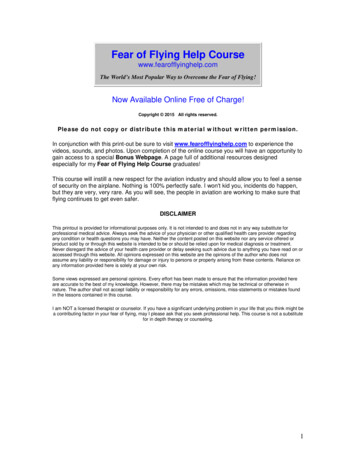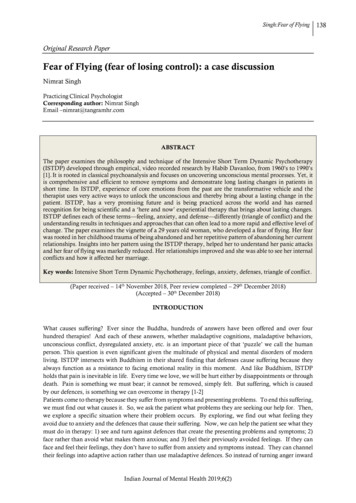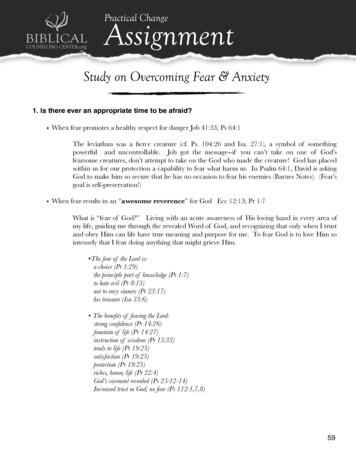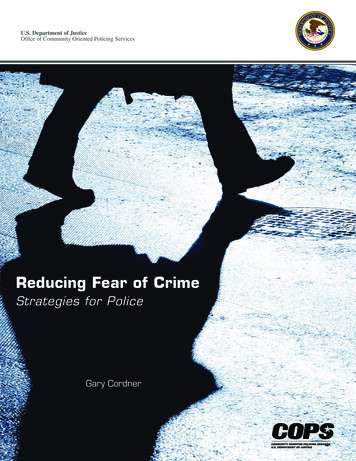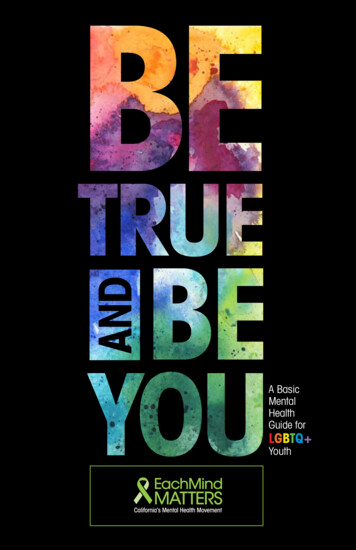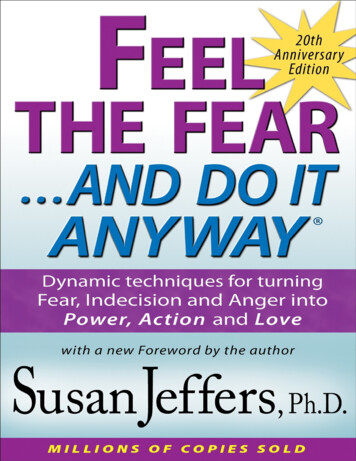
Transcription
FEEL THE FEAR . AND DO ITANYWAY Dynamic techniques for turning Fear, Indecision andAnger into Power, Action and LoveSusan Jeffers, Ph.D.
Copyright 1987, 2007 by Susan Jeffers, Ph.D.Jeffers Press A division of Susan Jeffers, LLCP.O. Box 5338Santa Monica, CA 90409Feel the Fear. and Do It Anyway is a registered trademark of Susan Jeffers,Ph.D.All rights reserved under International and Pan-American CopyrightConventions. No part of this publication may be reproduced or transmitted inany form or by any means, electronic or mechanical, including photocopying,recording, or any information storage and retrieval system, without permission inwriting from the publisher.ISBN: 978-1-938296-62-8
Praise forFEEL THE FEAR . . . AND DO ITANYWAY “Living is taking chances, and Feel the Fear and Do It Anyway has helpedso many people, both men and women, to achieve success.”— LOUISE L. HAYAuthor of You Can Heal Your Life“Should be required for every person who can read! I recommend this bookin every one of my seminars!”— JACK CANFIELDCo-author of Chicken Soup for the Soul“It’s a must! The most practical guide to personal empowerment I have everread. Feel the Fear . . . and Do It Anyway goes to number one on myrecommended reading list.”— JORDAN PAULCo-author of Do I Have to Give Up Me to Be Loved by You“[A book that] calls to the courageous soul in each of us—to which the soulanswers ‘Yes!’ so clearly that we cannot help but hear.”— GINI KOPECKY,Redbook“Comforting, practical, upbeat . . . a commonsense exercise program for themind.”— The San Diego Union“Unlike most books that purport to help the reader face life’s problems,Susan Jeffers is full of advice that is actually workable. Moreover, it’s apleasure to read.”— McCall’s
“Sage, commonsense advice. Useful for its encouragement and insights.”— Booklist“Unique . . . A truly revolutionary tool to fearless living!”— The Pilot
Books and Audios by Susan Jeffers,Ph.D.(in alphabetical order)Dare to Connect: Reaching Out in Romance, Friendship and the Workplace*Embracing Uncertainty: Breakthrough Methods for Achieving Peace of MindWhen Facing the Unknown*End the Struggle and Dance with Life: How to Build Yourself Up When theWorld Gets You Down*The Fear-Less SeriesInner Talk for a Confident Day*Inner Talk for a Love that Works*Inner Talk for Peace of Mind*The Feel the Fear SeriesFeel the Fear. and Beyond: Dynamic Techniques for Doing It Anyway*Feel the Fear and Do It Anyway: How to Turn Your Fear and Indecision intoConfidence and Action*The Feel the Fear Guide to Lasting Love*Feel the Fear Power Planner: 90 Days to a Fuller Life I Can Handle It: FiftyConfidence Building Stories for Children 3 - 7 (co-authored with DonnaGradstein) I’m Okay . You’re a Brat: Setting the Priorities Straight andFreeing You from the Guilt and Mad Myths of Parenthood* (Titled - FreeingOurselves from the Mad Myths of Parenthood* in the UK) Life is Huge!Laughing, Loving and Learning from it All Losing a Love and Finding a Life:Healing the Pain of a Broken Relationship Opening Our Hearts to Men:Transform Pain, Loneliness and Anger into Trust, Intimacy and Love*The Little Book of ConfidenceThe Little Book of Peace of Mind
Thoughts of Power and Love* (quotes from the works of Susan Jeffers) * Alsoavailable in audiotape and/or CDAUDIOTAPES FROM LIVE APPEARANCESThe Art of Fearbusting (also available in CD)A Fearbusting WorkshopFlirting from the HeartOpening Our Hearts to Each Otherwww.susanjeffers.com
For the wonderful gifts of life and love, I dedicate this book to the lovingmemory of my mother, Jeanne, and my father, Leon.I also dedicate this book to my jewel of a husband, Mark Shelmerdine, whobrings so much love and joy into my life. I am truly blessed.
Foreword to the 20th-AnniversaryEditionI do believe in miracles . . . and the success of Feel the Fear . . . and Do ItAnyway is a miracle to me. So many publishers rejected it in the beginning that Ialmost gave up trying to have it published. After all, if you received a rejectionletter, as I did, that said, “Lady Di could be cycling nude down the street givingthis book away, nobody would read it,” wouldn’t you be tempted to give uptrying?I actually did put the manuscript away in a drawer for a few years and almostforgot about it. One day, I decided to clean out that particular drawer . . . andthere it was . . . waiting for me. I sat down and read through it again. I couldn’tpush away the feeling that my book had something important to say. This time Imade a vow to myself: “Somehow I am going to find a way to get Feel the Fear. . . and Do It Anyway out into the world!” And so I “felt the fear” and tried onceagain to find a publisher. And this time, with a deep inner resolve and with thehelp of my agent, Dominick Abel, I found a publisher at last.Twenty years have passed since Feel the Fear . . . and Do It Anyway wasactually published. It is now in more than one hundred countries and has beentranslated into more than thirty languages. And that number continues to grow.From this continuous growth, one can conclude that the words I wrote so longago are as relevant today as they were then . . . if not more so!Fear will always be a part of all of our lives in one form or another. And thisapplies to people everywhere. From the letters of thanks I receive from all overthe world, it is clear that no matter who we are, no matter where we live, nomatter what we are experiencing in life, we all feel fear, but fear doesn’t need tohold us back from living a rich and beautiful life. We can overcome our fears byregularly using the powerful tools that lie within these pages.I thank those who have communicated with me for generously letting meknow that Feel the Fear . . . and Do It Anyway has made a huge difference in thequality of your lives. It brings me a special feeling of joy and humility to knowthat I have touched the lives of so many people.And for you “beginners” who are opening this book for the first time, trustme when I tell you that fear doesn’t have to hold you back. You, too, can learnhow to push through your fears—all of your fears—with a sense of power,
excitement, and love. And that’s what this book is all about.As you will discover, the concepts and tools you are about to learn are meantto be used for a lifetime. Learn them well. And every time a new challengecomes into your life, you need only reach into your “toolbox” and move yourselffrom the weakest to the strongest part of who you are. As you do so, you will beabsolutely amazed at the incredible amount of power you hold inside: power tolove, power to succeed, power to help the world in your own special way. Thejourney to the best of who you are is exciting and rewarding, and I am so happyto be walking right along with you as you take those first important steps.From my heart to yours,
IntroductionOPENING THE DOORWhat is it for you?Fear of . . .public speakingasserting yourselfmaking decisionsintimacychanging jobsbeing aloneagingdrivinglosing a loved oneending a relationship?Is it some of the above? All of the above? Perhaps you could add a few more tothe list. Never mind . . . join the crowd! Fear seems to be epidemic in oursociety. We fear beginnings; we fear endings. We fear changing; we fear“staying stuck.” We fear success; we fear failure. We fear living; we fear dying.Whatever the fear, this book will give you the insight and tools to vastlyimprove your ability to handle any given situation. You will move from a placeof pain, paralysis, and depression (feelings that often accompany fear) to one ofpower, energy, and excitement.You may be surprised and encouraged to learn that while inability to dealwith fear may look and feel like a psychological problem, in most cases it isn’t. Ibelieve it is primarily an educational problem, and that by reeducating the mind,you can accept fear as simply a fact of life rather than a barrier to success. (Thisshould be a relief to all of you out there who have been wondering “What’swrong with me?”) My conviction that fear can be dealt with through reeducationcame about through my own experiences. When I was younger, I was always runby fear, so it wasn’t surprising that for years I hung on to many things in my lifethat clearly were not working for me.Part of my problem was the nonstop little voice inside my head that kepttelling me, “YOU’D BETTER NOT CHANGE YOUR SITUATION. THERE’S
telling me, “YOU’D BETTER NOT CHANGE YOUR SITUATION. THERE’SNOTHING ELSE OUT THERE FOR YOU. YOU’LL NEVER MAKE IT ONYOUR OWN.” You know the one I’m talking about—the one that keepsreminding you, “DON’T TAKE A CHANCE. YOU MIGHT MAKE AMISTAKE. BOY, WILL YOU BE SORRY!”My fear never seemed to abate, and I didn’t have a moment’s peace. Evenmy doctorate in psychology didn’t seem to do me much good. Then one day, as Iwas dressing for work, I reached the turning point. I happened to glance in themirror, and I saw an all-too-familiar sight—eyes red and puffy from tears of selfpity. Suddenly rage welled up inside me, and I began shouting at my reflection,“ENOUGH . . . ENOUGH . . . ENOUGH!” I shouted until I had no more energy(or voice) left.When I stopped, I felt a strange and wonderful sense of relief and calm I hadnever felt before. Without realizing it at the time, I had gotten in touch with avery powerful part of myself that before that moment I hadn’t even knownexisted. I took another long look in the mirror and smiled as I nodded my headYES. The old familiar voice of doom and gloom was drowned out, at leasttemporarily, and a new voice had come to the fore—one that spoke of strengthand love and joy and all good things. At that moment I knew I was not going tolet fear get the best of me. I would find a way to rid myself of the negativismthat prevailed in my life. Thus, my odyssey began.An ancient sage once said, “When the student is ready, the teacher willappear.” The student was ready, and teachers appeared from all over the place. Ibegan to read, attend workshops, and talk to as many people as would listen.Diligently following every suggestion and lead, I unlearned the thinking that hadbeen keeping me a prisoner of my own insecurities. I began to see the world as aless threatening and more joyous place; I started to see myself as someone whohad purpose; and I experienced the meaning of love for the first time in my life.At this point I began to notice many other people struggling with the samebarriers I had finally learned to push through— the main barrier being fear. Howcould I help them? Realizing that the processes that had transformed my lifewere educational in nature, I was convinced that the same techniques I had usedcould be taught to anyone, regardless of age, sex, or background. I was able totest my theory in the real world by teaching a course at The New School forSocial Research, in New York City. Called “Feel the Fear . . . and Do ItAnyway,” the course was described as follows:Whenever we take a chance and enter unfamiliar territory or put ourselvesinto the world in a new way, we experience fear. Very often this fear keepsus from moving ahead with our lives. The trick is to FEEL THE FEAR
us from moving ahead with our lives. The trick is to FEEL THE FEARAND DO IT ANYWAY. Together we will explore the barriers that keep usfrom experiencing life the way we want to live it. So many of us shortcircuit our living by choosing the path that is the most comfortable.Through readings, class discussions, and interesting exercises we will learnto identify our excuses for “staying stuck” and develop the techniques fortaking control of our own lives.My experiment with taking the concept of fear out of the realm of therapy andplacing it in the area of education was extremely successful. My students wereamazed at how shifting their thinking magically reshaped their lives. Theconcepts worked for them as they had worked for me. And, not surprisingly, mystudents also became my teachers. They reaffirmed and added to my fund ofknowledge as I listened carefully to their wisdom.Those of you who are reading this book have acknowledged that whereveryou are in life at this moment is not exactly the place you want to be. Somethingneeds changing, and until now you haven’t been able to take the steps to changeit. Whatever your circumstances, you are ready to start taking charge of yourlife.I’m not promising that change is easy. It takes courage to mold your life theway you want it to be. There are all sorts of real and imagined obstacles that getin the way. They need not deter you. In your journey through this book you willbecome familiar with many concepts, exercises, and other devices to help youunravel the complexities of fear . . . and thus help you deal with it.You will learn:how it can be impossible to make a mistake or a wrong decision how to letgo of negative programming how it is impossible to be conned how to say“yes” to all circumstances in your life how to raise your level of self-esteemhow to become more assertive how to connect with the powerhouse withinhow to create more love, trust, and satisfaction how to deal with resistancefrom significant others as you take more control of your life how toexperience more enjoyment how to make your dreams become a realityhow to see yourself as having purpose and meaningAs you read, underline those sections of the book that “speak” to you, so thatlater you can easily find critical passages to help you face new situations in life.It takes a lot of reinforcement to incorporate new concepts into your behavior, socommit yourself to doing the exercises. The amount of improvement youexperience will depend on how much you are willing to actively participate.Also, the more you get involved, the more fun you will have. You will be
Also, the more you get involved, the more fun you will have. You will besurprised and pleased at the amount of satisfaction that comes as you take eachlittle step forward.No matter what degree of insecurity you are feeling, a part of you knowsthere is a lot of wonderful “stuff” within you just waiting to be let out, and NOWis the perfect time for opening the door to the power and love within.
am about to teach another fear class. The classroom is empty. I am waitingfor my new group of students to appear. My nervousness about teachingthese classes disappeared a long time ago. Not only have I taught it manytimes, but I also know my students before I meet them. They are like therest of us: all trying to do the best they can and all uncertain about whetherthey’re good enough. It never varies.As the students enter the room, I can feel the tension. They sit as far apartfrom one another as possible, until the seats between must be filled because oflack of space. They don’t talk to one another, but sit nervously, expectantly. Ilove them for their courage to admit that their lives are not working the way theywant them to work. And their presence in the class signifies that they are readyto do something about it.I begin by going around the room asking each student to tell the rest of uswhat he or she is having difficulty confronting in life. Their stories unfold:IDon wants to change his career of fourteen years and follow his dream ofbecoming an artist.Mary Alice is an actress who wants to discover why she finds all kindsof excuses for not attending auditions.Sarah wants to leave a marriage of fifteen years.Teddy wants to get over his fear of aging. He is all of thirty-two.Jean is a senior citizen who wants to confront her doctor; he treats herlike a child and never gives her any straight answers.Patti wants to expand her business, but can’t make the required leap tothe next step.Rebecca wants to confront her husband with things that have beenbothering her.Kevin wants to get over a fear of rejection that makes it very difficult toask a woman for a date.Laurie wants to know why she is unhappy when she has everything onecould possibly want in life.Richard is retired and feels useless. He fears his life is over.And so it goes until everyone’s story is heard.I’m fascinated with what happens during the go-around. As each personshares from the heart, the entire atmosphere begins to change. The tensionquickly fades and relief is expressed on everyone’s face.First, my students begin to realize that they are not the only ones in the worldfeeling afraid. Second, they begin to see how attractive people become as they
feeling afraid. Second, they begin to see how attractive people become as theyopen up and share their feelings. Long before the last person has spoken, afeeling of warmth and camaraderie pervades the room. They are strangers nomore.Although the backgrounds and situations of the class members vary greatly,it does not take long for the surface layers of their particular stories to disappear,opening the way for everyone to touch on a very human level. The commondenominator is the fact that fear is keeping all of them from experiencing life theway they want to experience it.The scenario above repeats itself in each fear class I teach. At this point youmight be wondering how one course can accommodate all the diverse fearsreported by the class members—their needs seem to be so varied. It’s true. Theydo seem varied until we dig a little deeper and look at the underlying cause of alltheir fears—and everyone else’s.Fear can be broken down into three levels. The first level is the surface story,such as the ones described above. This level of fear can be divided into twotypes: those that “happen” and those that require action. Here is a partial list ofLevel 1 fears divided into these types:LEVEL 1 FEARSThose that “Happen”AgingBecoming disabledRetirementBeing aloneChildren leaving homeNatural disastersLoss of financial securityChangeDyingWarIllnessLosing a loved oneAccidentsRapeThose Requiring ActionGoing back to schoolMaking decisions
Making decisionsChanging a careerMaking friendsEnding or beginning a relationship Going to the doctorAsserting oneselfLosing weightBeing interviewedDrivingPublic speakingMaking a mistakeIntimacyYou might have a few you can add to the list. As I hinted earlier, you wouldn’tbe alone if you said to yourself, “Some of the above” or even “All of the above.”There is a reason for this. One of the insidious qualities of fear is that it tends topermeate many areas of our lives. For example, if you fear making new friends,it then stands to reason that you also may fear going to parties, having intimaterelationships, applying for jobs, and so on.This is made clearer by a look at the second layer of fear, which has a verydifferent feel from that of Level 1. Level 2 fears are not situation-oriented; theyinvolve the ego.LEVEL 2 FEARSRejectionBeing connedSuccessHelplessnessFailureDisapprovalBeing vulnerableLoss of imageLevel 2 fears have to do with inner states of mind rather than exterior situations.They reflect your sense of self and your ability to handle this world. Thisexplains why generalized fear takes place. If you are afraid of being rejected,this fear will affect almost every area of your life—friends, intimaterelationships, job interviews, and so on. Rejection is rejection—wherever it isfound. So you begin to protect yourself, and, as a result, greatly limit yourself.
You begin to shut down and close out the world around you. Look over theLevel 2 list once again, and you will see how any one of these fears can greatlyimpact many areas of your life.Level 3 gets down to the nitty-gritty of the issue: the biggest fear of all—theone that really keeps you stuck. Are you ready?LEVEL 3 FEARI CAN’T HANDLE IT!“That’s it? That’s the big deal?” you may ask. I know you’re disappointed andwanted something much more dramatic than that. But the truth is this: AT THEBOTTOM OF EVERY ONE OF YOUR FEARSIS SIMPLY THE FEAR THAT YOU CAN’T HANDLEWHATEVER LIFE MAY BRING YOU.Let’s test this. The Level 1 fears translate to: I can’t handle illness.I can’t handle making a mistake.I can’t handle losing my job.I can’t handle getting old.I can’t handle being alone.I can’t handle making a fool out of myself.I can’t handle not getting the job.I can’t handle losing him/her.I can’t handle losing my money . . . etc.The Level 2 fears translate to: I can’t handle the responsibilities of success.I can’t handle failure.I can’t handle being rejected . . . etc.Thus Level 3—simply, “I can’t handle it!”The truth is:IF YOU KNEW YOU COULD HANDLE ANYTHINGTHAT CAME YOUR WAY,WHAT WOULD YOU POSSIBLY HAVE TO FEAR?The answer is: NOTHING!
I know you are probably not jumping up and down for joy just yet, butbelieve me when I tell you that I have just given you a great piece of news. WhatI have just told you means you can handle all your fears without having tocontrol anything in the outside world. This should be a tremendous relief. Youno longer have to control what your mate does, what your friends do, what yourchildren do, or what your boss does. You don’t have to control what happens atan interview, what happens at your job, what happens in your new career, whathappens to your money, or what happens in the stock market.ALL YOU HAVE TO DO TO DIMINISH YOUR FEAR IS TO DEVELOPMORE TRUST IN YOUR ABILITY TO HANDLE WHATEVER COMESYOUR WAY!I am belaboring the point because it is so critical. From this moment on,every time you feel afraid, remind yourself that it is simply because you are notfeeling good enough about yourself. Then proceed to use one or more of thetools in this book to help build yourself up. You have your task clearly mappedout for you. There is no reason for confusion.I’ve often been asked to explain why we have so little trust in ourselves. Idon’t really know the answer to that. I know that some fear is instinctual andhealthy, and keeps us alert to trouble. The rest—the part that holds us back frompersonal growth—is inappropriate and destructive, and perhaps can be blamedon our conditioning.In all my life I have never heard a mother call out to her child as he or shegoes off to school, “Take a lot of risks today, darling.” She is more likely toconvey to her child, “Be careful, darling.” This “Be careful” carries with it adouble message: “The world is really dangerous out there” . . . and . . . ”youwon’t be able to handle it.” What Mom is really saying, of course, is, “Ifsomething happens to you, I won’t be able to handle it.” You see, she is onlypassing on her lack of trust in her ability to handle what comes her way.I can remember wanting desperately to have a two-wheel bicycle and mymother’s refusal to buy me one. Her answer to my pleas was always the same: “Ilove you too much. I don’t want anything to happen to you.” I translated this tomean: “You are not competent enough to handle a two-wheel bike.” Havingbecome older and wiser, I realize now that she was really saying: “If anythinghappens to you, I will fall apart.”This overprotective mother of mine was once in intensive care after serioussurgery, with tubes down her nose and her throat. When I was told it was timefor me to leave, I whispered in her ear—not knowing if she could hear me—thatI loved her and would be back later. As I was walking toward the door, I heard a
I loved her and would be back later. As I was walking toward the door, I heard asmall, weak voice behind me saying—you guessed it— “Be careful.” Even inher anesthetic stupor, she was sending me admonitions of doom and gloom. AndI know she typifies the great percentage of mothers out there. Considering howmany “be carefuls” our parents bombarded us with, it is amazing that we evenmanage to walk out the front door!Apart from such seemingly obvious connections, the cause of our fear quitepossibly lies elsewhere. But does it really matter where our self-doubts comefrom? I believe not. It is not my approach to analyze the whys and wherefores oftroublesome areas of the mind. It is often impossible to figure out what theactual causes of negative patterns are, and even if we did know, the knowingdoesn’t necessarily change them. I believe that if something is troubling you,simply start from where you are and take the action necessary to change it.In this case, you know that you don’t like the fact that lack of trust inyourself is stopping you from getting what you want out of life. Knowing thiscreates a very clear, even laserlike, focus on what needs to be changed. Youdon’t have to scatter your energy wondering why. It doesn’t matter. Whatmatters is that you begin now to develop your trust in yourself, until you reachthe point where you will be able to say: WHATEVER HAPPENS TO ME,GIVEN ANY SITUATION,I CAN HANDLE IT!I can hear the doubting Thomases out there saying, “Oh, come on now, howdo you handle paralysis, or the death of a child, or cancer?” I understand yourskepticism. Remember that I was once a doubting Thomas myself. Just read onand let the book unfold. Give yourself a winning chance by using the toolsprovided throughout this book. As you do, you will find yourself coming closerand closer to such a high level of self-confidence that you will ultimately beginto realize that you can handle anything that comes your way. Never let thesethree little words out of your mind—possibly the three most important littlewords you’ll ever hear: I’LL HANDLE IT
anet’s still waiting for the fear to go away. She had always planned toreturn to college once her children were in school, but she now notices it’sbeen four years since her youngest child entered first grade. New excuseshave popped up since that time: “I want to be here when the children comehome from school”; “We really don’t have the money”; “My husband will feelneglected.”Although it is true that certain logistics would have to be worked out, that isnot the reason for her hesitation. In fact, her husband is willing to help her in anyway he can. He is concerned about her restlessness, and often encourages her tofulfill her lifelong dream of becoming a fashion designer.Each time Janet thinks about calling the local college to set up an interview,something stops her. “When I’m not so frightened, then I’ll make the call”;“When I feel a little better about myself, then I’ll make the call.” Most likelyJanet is going to wait a very long time.The problem is that her thinking is all mixed up. The logic she usesautomatically programs her for failure. She will never break the fear barrier untilshe is made aware of her faulty thinking; she simply does not “see” what isobvious to those who are out there doing it.Nor did I until I was forced to. Before my divorce from my first husband, Iwas rather like a child, allowing him to take over the practicalities of my life.After my divorce, I had no choice but to start doing things on my own. Smallthings, such as fixing the vacuum cleaner all by myself, brought me enormoussatisfaction. The first night I invited people to my home for dinner as a singleperson was a monumental leap. The day I booked tickets for my first trip withouta man was a day for celebration.As I began to do things on my own, I began to taste the deliciousness of anemerging self-confidence. It wasn’t all comfortable—in fact, a lot of it wasextremely uncomfortable. I felt like a child learning to walk and fallingfrequently. But with each step I felt a little surer of my ability to handle my life.As my confidence grew, I kept waiting for the fear to go away. Yet each timeI ventured out into a new territory, I felt frightened and unsure of myself.“Well,” I told myself, “just keep putting yourself out there. Eventually the fearwill go away.” It never did! One day a lightbulb went on in my head as Isuddenly realized the following “truth”:JTRUTH 1THE FEAR WILL NEVER GO AWAYAS LONG AS I CONTINUE TO GROW.
As long as I continued to push out into the world, as long as I continued tostretch my capabilities, as long as I continued to take new risks in making mydreams come true, I was going to experience fear. What a revelation! Like Janet,and so many of you reading this book, I had grown up waiting for the fear to goaway before I took any chances. “When I am no longer afraid . . . then!” Formost of my life, I had played the WHEN/THEN game. And it never worked.Once again you are probably not jumping up and down with joy. I am awarethat this revelation is not exactly one you wanted to hear. If you are like mystudents, you were hoping that my words of wisdom would miraculously makeyour fears go away. I’m sorry to say that it doesn’t work that way. On the otherhand, rather than think of it as a disappointment, consider it a relief that you nolonger have to work so hard on getting rid of the fear. It isn’t going to go away!Not to worry. As you build your confidence in yourself with the exercisessuggested herein, your relationship with fear will dramatically alter.Not long after discovering Truth 1, I made another important discovery thatcontributed enormously to my growth:TRUTH 2THE ONLY WAY TO GET RID OF THE FEAROF DOING SOMETHING IS TO GO OUT AND DO IT.This sounds contradictory to Truth 1, yet it isn’t. Fear of particular situationsdissolved when I finally confronted them. The “doing it” comes before the feargoes away.I can illustrate this by recounting my first teaching experience when I wasstudying for my doctorate. I was not much older than my students, and I wasteaching a subject in which I had dubious expertise—the psychology of aging. Ianticipated the first class period with a tremendous sense of dread. During thethree days prior to the class, my stomach felt like it was on a roller coaster. I hadprepared eight hours of work for a one-hour class. I had handwritten enoughmaterial for three lectures. None of this took away my fear. When the first day ofclass finally arrived, I felt like I was being sent to the guillotine. As I stood infront of my students, I could feel my heart pounding and my knees shaking.Somehow I got through that class period—not ecstatically looking forward to thesecond one the following week.Thankfully, thing
the list. Never mind . . . join the crowd! Fear seems to be epidemic in our society. We fear beginnings; we fear endings. We fear changing; we fear "staying stuck." We fear success; we fear failure. We fear living; we fear dying. Whatever the fear, this book will give you the insight and tools to vastly improve your ability to handle any .



